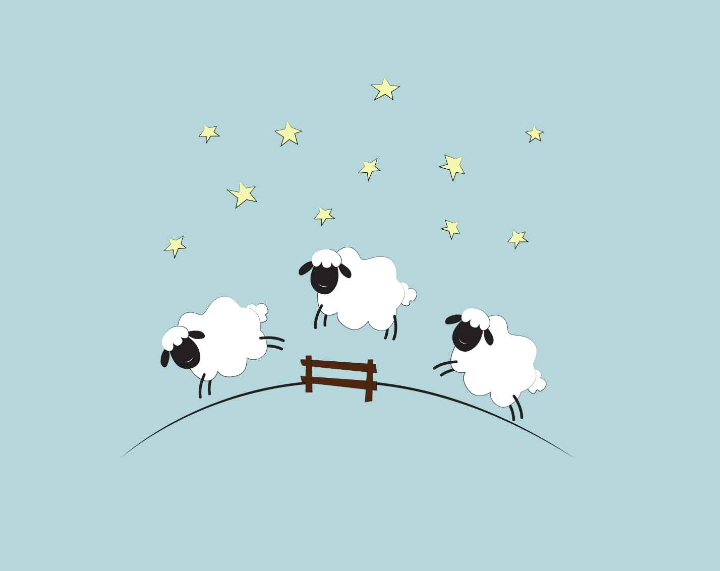Counting Sheep: Origins and Effectiveness for Better Sleep

The tradition of counting sheep to drift off to sleep is a practice deeply rooted in cultural folklore and historical anecdotes. It’s a whimsical remedy often suggested for those struggling with insomnia, a method purportedly dating back to medieval times when shepherds would find themselves in need of sleep after long, solitary days in the fields.
While the precise origin of this age-old technique remains somewhat shrouded in mystery, it’s commonly believed that the concept emerged as a simple and repetitive mental exercise to help quiet the mind and promote relaxation. The rhythmic act of counting sheep, envisioned as they gracefully leap over a fence one by one, is thought to provide a gentle distraction from intrusive thoughts and worries, allowing the mind to gradually unwind and embrace the drowsiness of sleep.
Historical references to counting sheep can be found in various literary works spanning centuries. One notable mention appears in the “Cento Novelle Antiche,” a collection of short stories from the 13th century, where a sleepy storyteller recounts a tale of a farmer attempting to ferry a flock of sheep across a swollen river, ultimately dozing off mid-story.
Similarly, the theme of counting sheep surfaces in Miguel de Cervantes’ iconic novel “Don Quixote,” albeit with a playful twist. In this classic literary masterpiece, Sancho Panza advises Don Quixote to tally goats instead of sheep, injecting a touch of humor into their nighttime musings.
These literary references not only highlight the enduring popularity of the practice but also underscore its universal appeal across different cultures and time periods. Whether it’s sheep, goats, or any other imaginative creature, the act of mentally counting and visualizing their peaceful procession serves as a tranquilizing ritual to ease the transition into sleep.
Despite its whimsical nature, counting sheep remains a cherished bedtime ritual for many, offering a timeless and comforting strategy for quieting the mind and embracing the serenity of sleep.
Is Counting Sheep Effective for Sleep?
Counting sheep has long been a popular bedtime ritual for those seeking to combat insomnia, but does it truly work? Research from over 20 years ago sheds light on this age-old question, although the study’s focus wasn’t specifically on counting sheep, according to senior author Allison Harvey, a professor of psychology and director of the Golden Bear Sleep and Mood Research Clinic at the University of California, Berkeley.
The study, conducted while Harvey was a professor at Oxford University, divided 50 participants into three groups. The first group received no specific instructions on how to fall asleep, while the second group was advised to distract themselves from thoughts, worries, and concerns using any method they preferred. The third group was tasked with engaging in vivid and captivating imagery tasks, such as visualizing a serene meadow or recalling a pleasant holiday memory.
Interestingly, participants who engaged in imagery reported significantly faster sleep onset compared to those in the other two groups. They also rated their thoughts and concerns as less distressing and uncomfortable. While a few individuals in the distraction group happened to count sheep as a method to induce sleep, this aspect of the study was not its primary focus.
Harvey emphasizes that while counting sheep might seem like a fun and lighthearted approach, it’s typically not sufficient to promote sleep on its own. Instead, she suggests exploring a variety of strategies tailored to individual preferences, as what works for one person may not be effective for another. Ultimately, finding the right combination of techniques is key to managing insomnia effectively.
What Strategies Can Help You Sleep?
There are scientifically supported methods to quiet your mind and facilitate sleep. Even after more than two decades, harnessing the power of your imagination remains a top recommendation, according to Harvey. Here are her additional suggestions:
Visualization of Relaxation: Creating a mental picture of a serene and pleasant environment can be effective, especially when engaging all five senses. Harvey advises making the imagery as vivid as possible by incorporating sights, sounds, smells, and even tastes.
Gratitude Practice: Expressing gratitude before bedtime has been shown to enhance happiness and promote relaxation. Take a moment to identify three things you’re grateful for and recite them to yourself as you prepare for sleep.
Savoring Moments: Reflecting on a positive experience from your day and reliving the emotions associated with it can help cultivate a sense of peace and tranquility conducive to sleep.
The following three techniques are best implemented prior to bedtime and focus on managing worry and repetitive thoughts:
Problem-Solving Exercise: Dedicate some time before bed to jot down your concerns and potential solutions on paper. This process helps to externalize worries and allows your mind to disengage from ruminating on them.
Journaling: Keeping a diary can serve as a means of capturing meaningful moments, blessings, or even worries. It provides an outlet for self-expression and reflection, helping to alleviate mental tension.
Scheduled Worry Time: Designate a specific period before bedtime to address any lingering concerns or worries. By setting aside dedicated time for worry, you can prevent intrusive thoughts from interfering with your ability to fall asleep.
By incorporating these strategies into your nightly routine, you can create a conducive environment for restful sleep without the need for counting sheep.